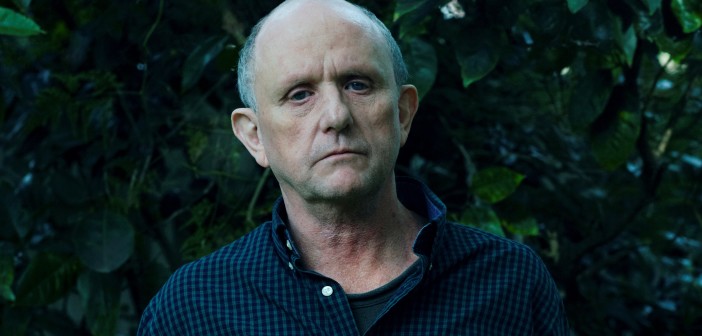Another special evening in Nick Shimmin’s lounge room in Camperdown, Sydney took place on Saturday 11th February when there was a screening of Malcolm McKinnon and Ross Gibson’s documentary film The Farmer’s Cinematheque:A Luminous Archive, followed by a solo recital on upright piano by Chris Abrahams, who also did the music for the film, which was premiered at the Adelaide Film Festival in October 2015.
The Farmer’s Cinematheque , which runs just under an hour, draws on the extraordinary film archive of Relvy Teasdale, which he started in the late 1930s, and which was continued by his son John into the early 2000s, and comprises hundreds of hours of film of rural life, which John stored under his bed with the camera and projector. On his death in 2004, John Teasdale, who was a ‘regional stringer’ cameraman for ABC television, left an archive of films about his and his father’s farm and community in the Wimmera in western Victoria, focusing particularly on a place called Rupanyup, population 320.
This archive of silent films, which John continued with video cameras and digital cameras, has been edited and commented on by McKinnon and Gibson, along with other members of the Teasdale family, most notably by Peter Teasdale, a fifth generation farmer and John’s son, and Acie Teasedale, his sister, an anthropologist and psychologist currently living in Epping, Sydney, who was present at the screening. The music is by Chris Abrahams, and the film was produced by Annie Venables, with cinematography by Ben Speth, for Reckless Eye Productions. The result is an extraordinary historical document of life in a farming community, exploring the relationship between filming and farming, and exhuming a number of ‘ghosts’ in what could be referred to as a rural hauntology.
The film includes scenes of John scanning the horizon and reciting the paddocks with the names of the people who farmed there, in a form of ‘chanting’, narrating the horizon or oral cartography. It also explores Aboriginal perspectives on the Wimmera, where middens are still evident, and through the accounts of Hazel McDonald and Regina Wood, present in the area since the 1960s, when their brother played football with the local team, and other ways of reading the country of this wheat belt district known as the plains, not far from Dimboola, mythologised by the playwright Jack Hibberd. The film makers cite Australian historian Greg Dening, who notes that “Historical understanding is an overlaying of images one on the other … it is cumulative and kaleidoscopic.” Abrahams’ music consists of a number of different instruments besides piano, including guitar and bell-like sounds, which provide a commentary on the often silent films’ sense of social memory and chronicle of the changes in Australian farming life throughout the 20th century. There is also a half hour radio account of the film, narrated by McKinnon, and also with Abrahams’ music, on the ABC program ‘Green Love’ part of the Series Earshot, in March 2016.
Abrahams’ tenth solo piano album, Climb (Vegetable VEGE003) is a departure from his previous few albums on which he has tended to use a variety of different keyboards in electo-acoustic mode. This is all solo piano, his first for a decade (Streaming in 2006), consisting of seven tracks, selected from hours of tapes, of varying length amounting to just over 40 minutes of music. As he has stated, “Over many years I have recorded my solo piano pieces with the intention of releasing a collection as a cohesive album. It’s a different way of working from going in to a studio to record a whole album in one go. It has allowed for the progression of time to be reflected in the work.”
‘Roller’ offers a relatively gentle opening gambit, with melodic sequences and a rippling, trebly, rhythm, followed by ‘The Sleeping and the Drifts’, a dreamier, slower and very euphonic piece, with his trademark shimmering, coming in at just over 9 minutes (timings are not listed). ‘Overlap’ reflects is structure in its title, a more methodically minimalist piece, with bass notes predominant, gradually evolving in phase patterns, while ‘Beach of Black Stones’ suggests the ebb and flow of a tide, back in the treble range, with a more arpeggiated structure, and is the shortest track at 3’43’’. ‘Fern Scrapes’ suggests the New Zealand bush, and we are back in bass territory, with a rapid, undulating tempo; ‘Dog Rose’ is perhaps evocative of a garden, with a trill in its legato melody, and a more cautious approach.
The final track, ‘Shoreline’, brings us back to the beach, and the rippling of water is predominant. Each track is distinctively different, with its own particular stamp, and Abrahams’ skill and control in improvisation is outstanding throughout. If composition is improvisation in the moment, this album has it in spades, and there is a notable melodic beauty throughout. It is 33 years since Abrahams’ debut solo album, simply called ‘Piano’ and consisting of nine improvisations which were recorded in the Recording Hall of the Sydney Opera House, and mastered, according to my vinyl copy on Hot Records, in Studio 301, where this album was also mastered. The opening track is entitled ‘Heavy Water’; another is called ‘Stormy Weather’, and while it is far less contained and restrained than the music on ‘Climb’, it suggests a virtuoso pianist in the making. It is a delight to hear how he has developed.




